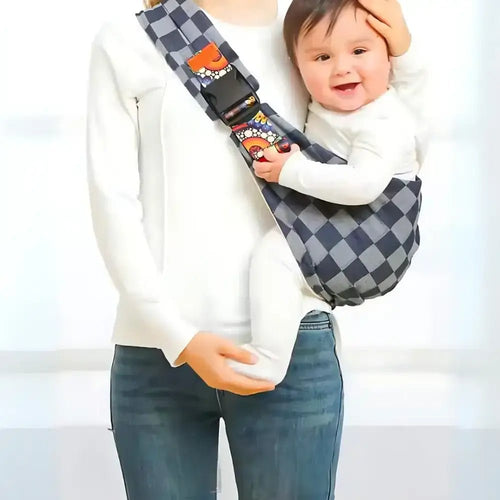
The Ultimate Guide to Choosing the Right Baby Carrier
Newborn, infant, or on-the-go toddler—this guide explains carrier types, the safety basics, hip-healthy fit, and how twin families can use carriers effectively. You’ll also find breastfeeding-friendly tips and an easy checklist to choose the right model.
Key takeaways
- Safety first: Baby’s face visible; chin off chest; fabric clear of nose/mouth; snug, high carry.
- Hip-healthy position: “M” position—knees higher than bottom, thighs well supported.
- Best all-rounder: A quality soft structured carrier (SSC) fits most families for the longest time.
- Twin families: Twin-specific models help early; a single ergonomic SSC is often the most versatile long-term tool (one baby at a time).
- Fit matters more than features: Adjustable straps, supportive waist belt, and breathable fabric beat gimmicks.
Why babywearing helps
- Hands-free comfort: Keep baby close while moving safely at home or on short errands.
- Soothing & bonding: Upright cuddles can calm fussiness and support contact naps.
- Practical routine: Easier than a stroller for quick tasks or stairs; great between feeds.
Carrier types (pros/cons & age ranges)

1) Soft Structured Carrier (SSC)
What it is: Padded shoulder straps + supportive waist belt + structured panel.
- Pros: Fast to put on; best weight distribution; grows with baby; great for daily use.
- Cons: Slightly bulkier in a diaper bag than wraps.
- Typical age/weight: Newborn (with insert or small-baby setting) through toddler, per brand limits.
2) Stretchy Wrap
What it is: Long, soft knit fabric tied around your body.
- Pros: Cozy newborn snuggles; inexpensive; great at home.
- Cons: Learning curve to tie; less supportive as baby gets heavier.
- Typical age/weight: Best for the first months; check brand max weight.
3) Woven Wrap
What it is: Non-stretch woven fabric; many tying options.
- Pros: Very versatile (front/hip/back carries); supportive for bigger babies.
- Cons: Highest learning curve; long fabric can drag while tying outdoors.
- Typical age/weight: Newborn to toddler, depending on weave/length and your skill.
4) Ring Sling
What it is: One-shoulder sling tightened through rings.
- Pros: Quick on/off; great for short hip carries and contact naps.
- Cons: One-shoulder load not ideal for long wear.
- Typical age/weight: Newborn through toddler, for short periods.
5) Hybrid/Meh Dai
What it is: Panel with wrap-like ties—softer than an SSC, easier than a wrap.
- Pros: Comfortable, adjustable; simple learning curve.
- Cons: Less common and fewer accessories than SSCs.
- Typical age/weight: Varies by brand; check limits.
Safety essentials (airway & hip-healthy fit)
- Airway clear: Keep baby’s face visible at all times; no fabric over nose/mouth; chin off chest.
- Snug & high: “Close enough to kiss” height; tighten slack for full support.
- Hip-healthy “M” position: Knees higher than bottom; pelvis tilted; thighs supported knee-to-knee.
- Follow limits: Respect the carrier’s age/weight guidance and position rules.
- Special cases: Prematurity, reflux, respiratory or orthopedic concerns—ask your pediatric clinician/IBCLC.
Educational only; not medical advice.
Fit, sizing & comfort
- Strap range: Choose adjustable straps that fit smaller and larger caregivers.
- Support: A padded, contoured waist belt reduces shoulder strain as baby grows.
- Fabric & climate: Breathable mesh or cotton for warm weather; easy-care fabrics for daily use.
- Try & tweak: Use a mirror at first; tighten from the waist upward; re-adjust after feeding.
Single vs twin use
Twin-specific carriers can be helpful in the early months, but many families find a single ergonomic SSC the most practical long-term choice—carrying one baby at a time while the other rests in a stroller/bassinet, or caregivers split duties. As babies grow, a single SSC usually offers the best support, value, and everyday speed.
How to choose: quick checklist
- Daily use or special occasions? For everyday, pick an SSC; for short soothing sessions, a stretchy wrap or sling can complement.
- Fit for your body: Wide strap range, supportive waist, and easy buckles.
- Newborn support: Look for infant adjustments/inserts and head/neck support.
- Breathability: Mesh panels or light cotton for warm climates.
- Longevity & value: Check min/max weight, multi-position options, and washability.
How to put on an SSC (step-by-step)
- Secure the waist belt at your natural waist; tighten snugly.
- Hold baby high on your chest; slide baby’s legs into the seat, keeping the “M” position.
- Bring up the panel; place one shoulder strap, then the other; buckle the chest/back clip.
- Tighten shoulder straps to remove slack. You should be able to kiss the top of baby’s head.
- Do a final airway check (face visible, chin off chest). Re-check after 10 minutes and after any feed.
Breastfeeding-friendly tips
- Practice at home first. Loosen very slightly to latch; re-tighten and re-position upright afterward.
- Use a burp cloth to protect the panel. Keep baby’s face visible at all times.
- Between feeds, some moms use silver nursing cups for nipple comfort (remove before feeding).
- For outdoor privacy, a light muslin nursing cover can help—ensure airflow and visibility.


